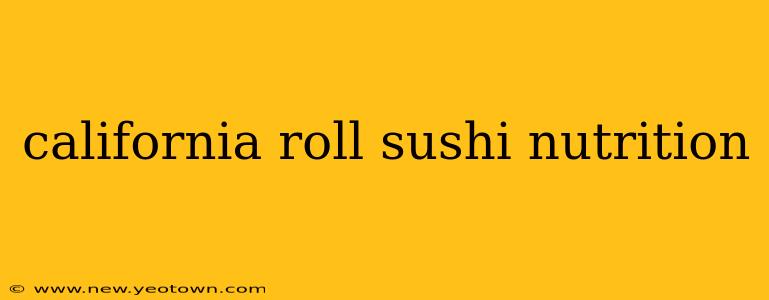Ah, the California roll. A sushi staple, a crowd-pleaser, and often the gateway to the wonderful world of raw fish (even if it doesn't contain any!). But have you ever stopped to wonder what exactly you're consuming when you indulge in this delicious creation? Let's unroll the nutritional facts and explore the nutritional profile of this beloved sushi roll.
What are the main ingredients in a California roll?
The beauty of the California roll lies in its simplicity. Typically, it features cooked ingredients, making it a safe bet for those wary of raw fish. The core components are:
- Surimi (imitation crab meat): This processed seafood stands in for real crab, contributing protein and a satisfying texture.
- Avocado: A creamy, healthy fat source packed with vitamins and fiber.
- Cucumber: Providing crunch, hydration, and a refreshing element.
- Sushi Rice: The foundation of the roll, offering carbohydrates for energy.
- Nori (seaweed): A thin sheet wrapping the roll, contributing a subtle salty flavor and a source of minerals.
- Mayonnaise: Often added for richness and creaminess.
How many calories are in a California roll?
The calorie count of a California roll can vary considerably depending on the size of the roll, the specific ingredients used, and the amount of mayonnaise. A standard California roll typically contains between 200-300 calories. However, if you opt for larger rolls or those loaded with extra mayonnaise, the calorie count can climb higher.
Is a California roll healthy?
The healthfulness of a California roll depends heavily on portion size and ingredients. While it doesn't contain raw fish, which is a significant source of omega-3 fatty acids, it does offer some nutritional benefits:
- Avocado: Rich in healthy monounsaturated fats, fiber, and potassium.
- Cucumber: Low in calories and a good source of hydration.
- Sushi Rice: Provides carbohydrates for energy, but refined grains are not as nutritious as whole grains.
- Nori: Contains small amounts of vitamins and minerals.
However, potential drawbacks include:
- High Sodium: Surimi and soy sauce can be relatively high in sodium.
- High Carbohydrates: The rice is a significant source of carbohydrates.
- Added Sugar: Some California rolls might contain added sugar in the mayonnaise or rice.
- Processed Ingredients: Surimi is a processed food, which might contain additives.
What are the macros in a California roll?
A typical California roll's macronutrient breakdown might look something like this (values will vary):
- Calories: 250-300
- Protein: 8-10 grams
- Fat: 10-15 grams
- Carbohydrates: 30-40 grams
It's crucial to remember these are estimates, and the actual macro values may vary depending on the restaurant and preparation.
Are California rolls good for weight loss?
While a California roll can be part of a balanced diet, it's not necessarily ideal for weight loss. The carbohydrates from the rice and the potential for added mayonnaise can contribute to calorie intake. Moderation is key. If weight loss is your goal, consider focusing on a balanced diet rich in whole foods and mindful portion control.
Are California rolls keto-friendly?
No, California rolls are generally not keto-friendly due to the significant amount of carbohydrates from the sushi rice. The carbs far exceed the limits of a standard ketogenic diet.
In conclusion, the California roll offers a delicious and relatively accessible entry point into the world of sushi. However, like many foods, moderation and awareness of its nutritional content are key to enjoying it as part of a healthy lifestyle. Pay attention to portion sizes and be mindful of added ingredients to maximize the nutritional benefits and minimize potential downsides. Always check with your doctor or a registered dietitian if you have any specific dietary concerns or restrictions.

